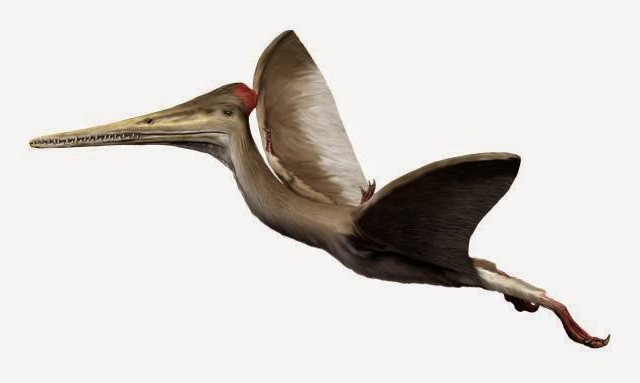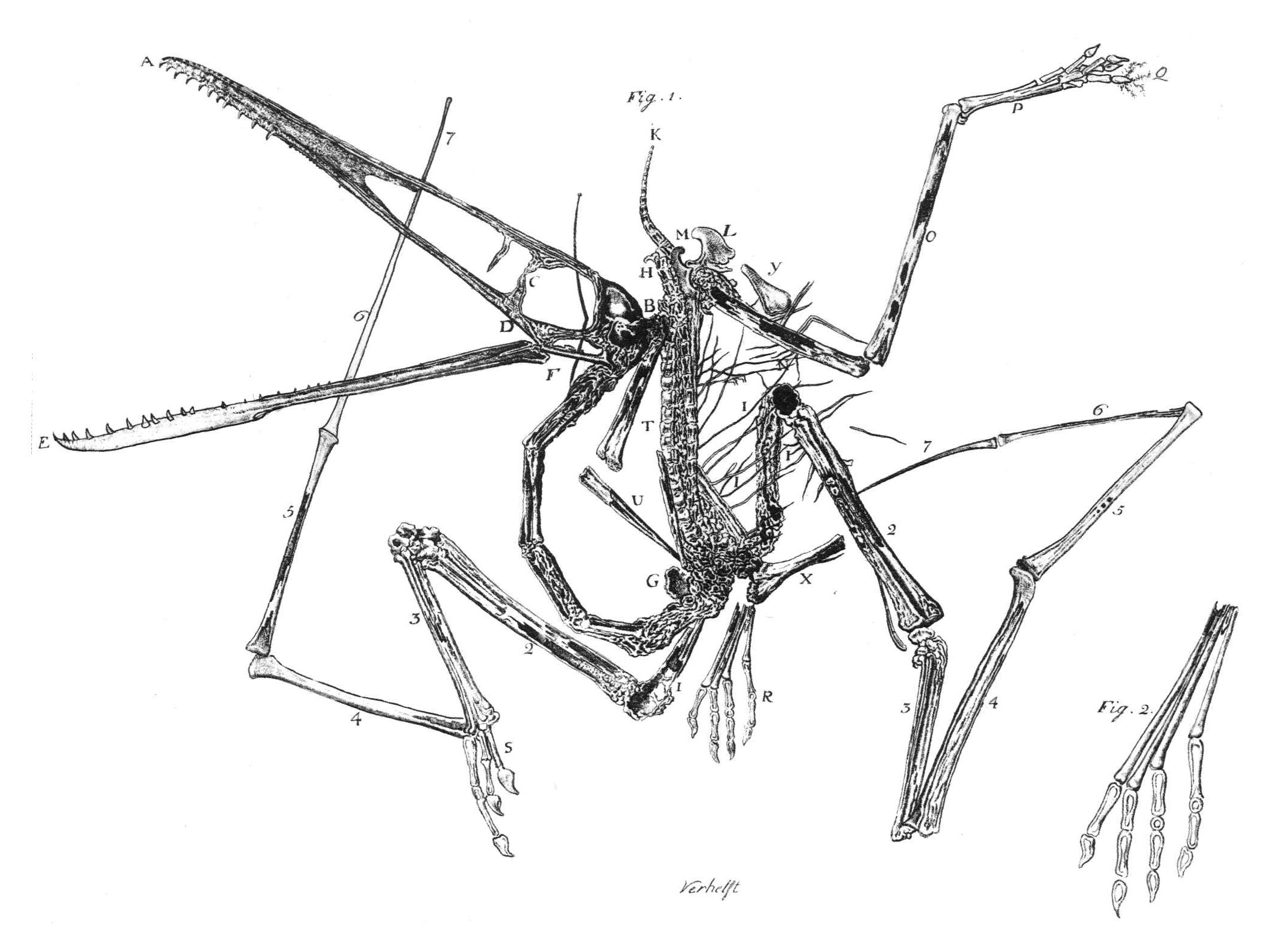|
Pterodactyloidea
Pterodactyloidea (derived from the Greek words ''πτερόν'' (''pterón'', for usual ''ptéryx'') "wing", and ''δάκτυλος'' (''dáktylos'') "finger" meaning "winged finger", "wing-finger" or "finger-wing") is one of the two traditional suborders of pterosaurs ("wing lizards"), and contains the most derived members of this group of flying reptiles. They appeared during the middle Jurassic Period, and differ from the basal (though paraphyletic) rhamphorhynchoids by their short tails and long wing metacarpals (hand bones). The most advanced forms also lack teeth, and by the late Cretaceous, all known pterodactyloids were toothless. Many species had well-developed crests on the skull, a form of display taken to extremes in giant-crested forms like '' Nyctosaurus'' and '' Tupandactylus''. Pterodactyloids were the last surviving pterosaurs when the order became extinct at the end of the Cretaceous Period, together with the non-avian dinosaurs and most marine reptiles. " Pter ... [...More Info...] [...Related Items...] OR: [Wikipedia] [Google] [Baidu] |
Pterosaur
Pterosaurs (; from Greek ''pteron'' and ''sauros'', meaning "wing lizard") is an extinct clade of flying reptiles in the Order (biology), order, Pterosauria. They existed during most of the Mesozoic: from the Late Triassic to the end of the Cretaceous (228 to 66 million years ago). Pterosaurs are the earliest vertebrates known to have evolved flying and gliding animals, powered flight. Their wings were formed by a membrane of skin, muscle, and other tissue (biology), tissues stretching from the ankles to a dramatically lengthened fourth finger. There were two major types of pterosaurs. Basal pterosaurs (also called 'non-pterodactyloid pterosaurs' or 'rhamphorhynchoids') were smaller animals with fully toothed jaws and, typically, long tails. Their wide wing membranes probably included and connected the hind legs. On the ground, they would have had an awkward sprawling posture, but the anatomy of their joints and strong claws would have made them effective climbers, and some ... [...More Info...] [...Related Items...] OR: [Wikipedia] [Google] [Baidu] |
Kryptodrakon
''Kryptodrakon'' is an extinct genus of pterodactyloid pterosaur from the Middle to Late Jurassic with an age of approximately 162.7 million years. It is known from a single type species, ''Kryptodrakon progenitor''. The age of its fossil remains made ''Kryptodrakon'' the basalmost and oldest pterodactyloid known to date. Discovery and naming In 2001, pterosaur bones were discovered in Xinjiang by Chris Sloan. The bones were first identified as those of a theropod; paleontologist James Clark later recognized their pterosaurian nature. In 2014, Brian Andres, Clark and Xu Xing named and described the type species ''Kryptodrakon progenitor''. The generic name means ''hidden dragon'' from Greek κρυπτός, ''kryptos'' (''hidden''), and δράκων, ''drakon'' (''dragon''). The name alludes to the film ''Crouching Tiger, Hidden Dragon,'' which included some scenes filmed near the type locality. The specific name ''progenitor'' means ''ancestor'' or ''founder of a family'' in ... [...More Info...] [...Related Items...] OR: [Wikipedia] [Google] [Baidu] |
Pterodactylus Antiquus
''Pterodactylus'' (from Greek () meaning 'winged finger') is an extinct genus of pterosaurs. It is thought to contain only a single species, ''Pterodactylus antiquus'', which was the first pterosaur to be named and identified as a flying reptile. Fossil remains of ''Pterodactylus'' have primarily been found in the Solnhofen limestone of Bavaria, Germany, which dates from the Late Jurassic period (early Tithonian stage), about 150.8 to 148.5 million years ago. More fragmentary remains of ''Pterodactylus'' have tentatively been identified from elsewhere in Europe and in Africa. ''Pterodactylus'' was a generalist carnivore that probably fed on a variety of invertebrates and vertebrates. Like all pterosaurs, ''Pterodactylus'' had wings formed by a skin and muscle membrane stretching from its elongated fourth finger to its hind limbs. It was supported internally by collagen fibres and externally by keratinous ridges. ''Pterodactylus'' was a small pterosaur compared to other fam ... [...More Info...] [...Related Items...] OR: [Wikipedia] [Google] [Baidu] |
Archaeopterodactyloidea
Archaeopterodactyloidea (meaning "ancient Pterodactyloidea") is an extinct clade of pterodactyloid pterosaurs that lived from the middle Late Jurassic to the latest Early Cretaceous periods (Kimmeridgian to Albian stages) of Africa, Asia, Europe and North America. It was named by Alexander Wilhelm Armin Kellner in 1996 as the group that contains '' Germanodactylus'', ''Pterodactylus'', the Ctenochasmatidae and the Gallodactylidae. In 2003, Kellner defined the clade as a node-based taxon consisting of the last common ancestor of ''Pterodactylus'', '' Ctenochasma'' and '' Gallodactylus'' and all its descendants. Although phylogenetic analyses that based on David Unwin's 2003 analysis do not recover monophyletic Archaeopterodactyloidea, phylogenetic analyses that based on Kellner's analyses, or the analyses of Brian Andres (2008, 2010, 2018) recover monophyletic Archaeopterodactyloidea at the base of the Pterodactyloidea. The Antarctic Campanian specimen MN 7801-V was referred t ... [...More Info...] [...Related Items...] OR: [Wikipedia] [Google] [Baidu] |
Eupterodactyloidea
Eupterodactyloidea (meaning "true Pterodactyloidea") is an extinct group of pterodactyloid pterosaurs that existed from the latest Late Jurassic to the latest Late Cretaceous periods (Tithonian to Maastrichtian stages). Eupterodactyloids lived on all continents except Antarctica. Classification Eupterodactyloidea was named by S. Christopher Bennett in 1994 as an infraorder of the suborder Pterodactyloidea. Bennett defined it as an apomorphy-based clade. However, in 2010, Brian Andres re-defined the group as a stem-based taxon in his dissertation, and then formalized the definition in 2014 as all pterosaurs more closely related to ''Pteranodon longiceps'' than to ''Pterodactylus antiquus''. The slightly more exclusive group Ornithocheiroidea was re-defined in 2003 by Alexander Kellner. He defined it as the least inclusive clade containing ''Anhanguera blittersdorffi'', ''Pteranodon longiceps'', ''Dsungaripterus weii'', and ''Quetzalcoatlus northropi''. Ornithocheiroidea has often ... [...More Info...] [...Related Items...] OR: [Wikipedia] [Google] [Baidu] |
Quetzalcoatlus
''Quetzalcoatlus'' is a genus of pterosaur known from the Late Cretaceous period of North America (Maastrichtian stage); its members were among the largest known flying animals of all time. ''Quetzalcoatlus'' is a member of the Azhdarchidae, a family of advanced toothless pterosaurs with unusually long, stiffened necks. Its name comes from the Aztec feathered serpent god Quetzalcoatl. The type species is ''Q. northropi'', named by Douglas Lawson in 1975; the genus also includes the smaller species ''Q. lawsoni'', which was known for many years as an unnamed species before being named by Brian Andres and Wann Langston Jr. (posthumously) in 2021. Discovery and species The first ''Quetzalcoatlus'' fossils were discovered in Texas, United States, from the Maastrichtian Javelina Formation at Big Bend National Park (dated to around 68 million years ago) in 1971 by Douglas A. Lawson, then a geology graduate student from the Jackson School of Geosciences at the University of Texas ... [...More Info...] [...Related Items...] OR: [Wikipedia] [Google] [Baidu] |
Rhamphorhynchoidea
The Rhamphorhynchoidea forms one of the two suborders of pterosaurs and represents an evolutionary grade of primitive members of flying reptiles. This suborder is paraphyletic unlike the Pterodactyloidea, which arose from within the Rhamphorhynchoidea as opposed to a more distant common ancestor. Because it is not a completely natural grouping, Rhamphorhynchoidea is not used as a formal group in most scientific literature, though some pterosaur scientists continue to use it as an informal grouping in popular works, such as ''The Pterosaurs: From Deep Time'' by David Unwin, and in some formal studies. Rhamphorhynchoids were the first pterosaurs to have appeared, in the late Triassic Period (Norian age, about 210 million years agoButler, R.J., Barrett, P.M., and gower, D.J. (2009). "Postcranial skeletal pneumaticity and air-sacs in the earliest pterosaurs." ''Biology Letters'', 5(4): 557–560. ). Unlike their descendants, the pterodactyloids, most rhamphorhynchoids had teeth and lon ... [...More Info...] [...Related Items...] OR: [Wikipedia] [Google] [Baidu] |
Ningchengopterus
''Ningchengopterus'' is a genus of pterodactyloid pterosaur from the Early Cretaceous period (Aptian stage). Its fossil remains were found in the Yixian Formation of what is now China. It is known from a juvenile specimen, holotype CYGB-0035, an almost complete articulated skeleton of a hatchling also showing soft parts, such as the flight membrane and pycnofibres, compressed on a plate and counterplate. It was the first small toothed pterodactyloid pterosaur specimen found in China. The type species ''Ningchengopterus liuae'' was named and described by Lü Junchang in 2009. The genus name combines a reference to the Ningcheng district in Inner Mongolia with a Latinised Greek ''pteron'', "wing". The specific name honours Ms Liu Jingyi who collected the fossil and donated it to science. ''Ningchengopterus'' was typified by the possession of about fifty teeth, twelve in each upper jaw and thirteen in each lower jaw. The teeth are curved, conical and pointed. The skull has a le ... [...More Info...] [...Related Items...] OR: [Wikipedia] [Google] [Baidu] |
Herbstosaurus
''Herbstosaurus'' is the name given to a genus of pterosaurs that lived during the Late Jurassic period, in what is now Argentina. In 1969 Argentine paleobotanist Rafael Herbst in the province Neuquén at Picun Leufú dug up a piece of sandstone holding a number of disarticulated bones of a small reptile. At the time it was assumed the rock dated to the Middle Jurassic (Callovian), about 163 million years ago. In 1974/1975 paleontologist Rodolfo Magín Casamiquela named the find as a new genus. The type species is ''Herbstosaurus pigmaeus''. The genus name honours Herbst and connects his name to Greek ''sauros'', "lizard", a usual element in the name of dinosaurs — Casamiquela assumed the new genus was a theropod dinosaur. The specific name is derived from Greek ''pygmaios'', "dwarf": it was thought the form presented a small ''Compsognathus''-like coelurosaurian belonging to the Coeluridae and one of the smallest dinosaurs then known. Description The holotype is CTES-P ... [...More Info...] [...Related Items...] OR: [Wikipedia] [Google] [Baidu] |
Dermodactylus
''Dermodactylus'' (meaning "skin finger", from Greek ''derma'' and ''daktylos'', in reference to pterosaur wings being skin membranes supported by the ring fingers) was a genus of pterodactyloid (general term for "short-tailed" pterosaur) pterosaur from the Kimmeridgian-Tithonian-age Upper Jurassic Morrison Formation of Wyoming, United States. It is based on a single partial bone, from the hand. History and classification ''Dermodactylus'' is based on a single distal right fourth metacarpal found by Samuel Wendell Williston at Como Bluff, Wyoming in 1878; this bone is currently housed in the collections of the Yale Peabody Museum of Natural History in New Haven, Connecticut (YPM 2020YPM=Yale University Peabody Museum of Natural History, New Haven, Connecticut.). This bone constituted at the time the oldest pterosaur remains found, recognized, and described from North America. Othniel Charles Marsh first named it as a species of ''Pterodactylus'': ''P. montanus'', the specific ... [...More Info...] [...Related Items...] OR: [Wikipedia] [Google] [Baidu] |
Pterodactyl (other) , a pterosaur often used as a basis for com ...
Pterodactyl is an informal term for pterosaurs, based on the genus of the first pterosaur known to science, ''Pterodactylus antiquus''. Pterodactyl may also refer to: * ''Pterodactyl'' (film), a horror film *Westland-Hill Pterodactyl, a series of experimental aircraft designs starting in the 1920s * Chengdu Pterodactyl I, an unmanned aerial vehicle developed in the People's Republic of China *Pterodactyl Ascender, a family of ultralight aircraft that were sold in kit form between 1979 and 1984 See also * Pterodactylid, a pterosaur of the family Pterodactylidae * Pterodactyloid, a pterosaur of the suborder Pterodactyloidea * Pterosaur, an archosaur of the order Pterosauria * Pteranodon ''Pteranodon'' (); from Ancient Greek (''pteron'', "wing") and (''anodon'', "toothless") is a genus of pterosaur that included some of the largest known flying reptiles, with ''P. longiceps'' having a wingspan of . They lived during the late C ... [...More Info...] [...Related Items...] OR: [Wikipedia] [Google] [Baidu] |






